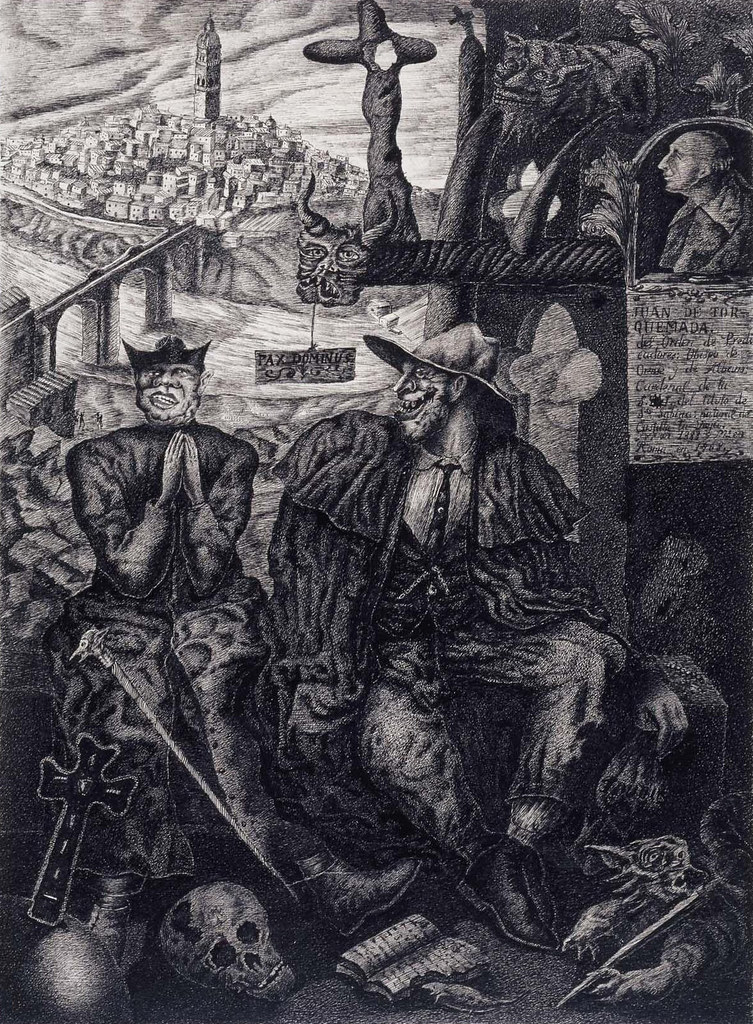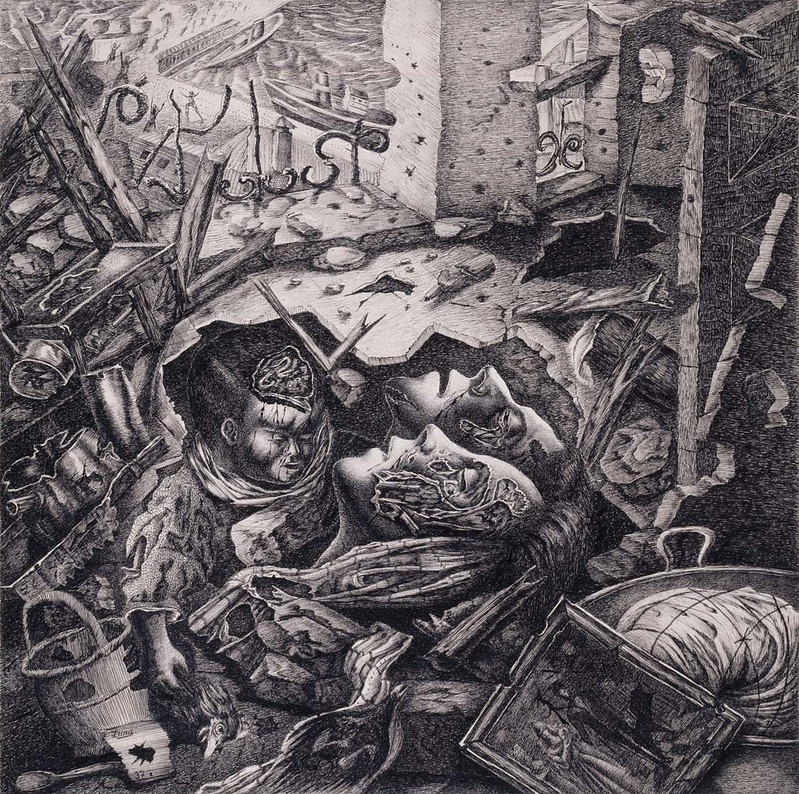----
William Strang (Scottish, 1859-1921)Illustrations for Paradise...
// The Curve in the Line
William Strang (Scottish, 1859-1921)
Illustrations for Paradise Lost by John Milton, 1896
----
Shared via my feedly newsfeed
Sent from my iPhone
William Strang (Scottish, 1859-1921)
Illustrations for Paradise Lost by John Milton, 1896
Cartoonist, caricaturist, comics artist and illustrator illustrator Jack Davis had a pen that connected directly to the funny bone.
Noted for his horror comics work for EC Comics and Warren magazines, his movie posters, TV Guide covers, celebrity caricatures and, in particular, his loopy, wild, frenetic, over-the-top and uncannily hilarious comics and covers for Cracked and MAD Magazine, Davis influenced cartoonists and comics artists across the board.
Davis often left his readers in simultaneous paroxysms of laughter and wide-eyed admiration for his drawing skills, producing contorted reading positions that looked like.. well, like jack Davis illustrations.
Jack Davis died on July 27, 2016 at the age of 92.
The links below are mostly to recent obits and articles. For more links to image resources, see my previous post on Jack Davis.
 | Thomas Ragon (@ThomasRagon) |
Moebius originals - law & order for Tombstone, hangover... pic.twitter.com/kgdW0pV7nv | |
 | Comics Alliance (@comicsalliance) |
Greatest Hits: A Visual Tribute To The Great Jack Davis. trib.al/ApC0xsl pic.twitter.com/gmAy6oZYhU | |
 | JodoEnglish (@AlejodoEnglish) |
Do not worry so much about arriving, but about advancing. To be advancing is to be arriving. | |
 | Maria Popova (@brainpicker) |
Gustave Doré's hauntingly beautiful illustrations for Dante's 'Inferno' brainpickings.org/2015/10/02/gus… pic.twitter.com/TAm1hkObzM | |
 | Duncan Fegredo (@duncanfegredo) |
I'll be at #LFCC on Sunday morning along with @seanpphillips I'll have a few A4 originals with me! @Showmasters pic.twitter.com/4BfeD65snp | |
 | Bibliophilia (@Libroantiguo) |
Alice B. Woodward (1862–1951), was one of the most prolific illustrators of the 20th c.The Story of the Mikado, 1921 pic.twitter.com/GPEBfrVIx5 | |
 | io9 (@io9) |
Artist creates a stunning version of an El Greco classic using only string on.io9.com/IWeo22M pic.twitter.com/blNLoVL895 | |
 | WeirdlyComics (@WeirdlyComics) |
TOTALLY forgot about this MIGNOLA drawing of The ROCKETEER glad I stumbled across it... pic.twitter.com/b9mB7j5RBt | |
 | Colleen Doran (@ColleenDoran) |
BTW the only known photo of JC Leyendecker's model and lover Charles Beach. Sorry can't recall where I pinched this. pic.twitter.com/GC5hP2Aj2y | |
Hailing a partnership between House of Illustration and St Pancras International holding their summer series of illustration events, Quentin Blake has created an original illustration of Roald Dahl's BFG to be exhibited in the station.
Madrid-based artist and illustrator José Quintanar AKA José Ja Ja Ja has a stripped-back, simple drawing style that focuses on the impression and outlines of objects and figures rather than the intricate details. In his new book, Fartlek his sparse drawings are unleashed over 400 pages and the artist captures various everyday items and belongings like cars, bikes, basketballs and the landscapes of La Mancha, as well as blob-like characters.
 The Carlist Militiaman, 1937
The Carlist Militiaman, 1937 The Dictator, 1937
The Dictator, 1937 The Falangist, 1937
The Falangist, 1937 The Inquisition [of the Church, 1937
The Inquisition [of the Church, 1937 Land-Owner, 1938
Land-Owner, 1938 Andalusian Land-Owner. 1937-38
Andalusian Land-Owner. 1937-38 Barcelona Air Raid, 1938
Barcelona Air Raid, 1938 Homage to Bécquer, 1936
Homage to Bécquer, 1936 The Fifth Column, 1938
The Fifth Column, 1938 The War, 1938
The War, 1938 They Also Give Land to the Peasants, 1937
They Also Give Land to the Peasants, 1937 Oviedo Prison, 1934
Oviedo Prison, 1934 Air Raid on Colmenar Viejo, 1937
Air Raid on Colmenar Viejo, 1937My old tutorial! Wanna share it with you)
 | Nautilus (@NautilusMag) |
This is what musical notes actually look like: go.nautil.us/music_shapes pic.twitter.com/Ncvse9EEv6 | |
 | Ray Harryhausen (@Ray_Harryhausen) |
Early drawing of Medusa from 'Clash of the Titans', drawn in 1977 & used to pitch the film to MGM! #Harryhausen100 pic.twitter.com/D1UOLQy61d | |
 | Thomas Ragon (@ThomasRagon) |
Lynd Ward, color lithographs for RL Stevenson's "The Master of Ballantræ" pic.twitter.com/XvKmjwuO52 | |
 | Renae De Liz (@RenaeDeLiz) |
Q: As an artist, what can I consider if I want to de-objectify & add power to female characters? Tips in this thread pic.twitter.com/DEKF1p6YFd | |
As I've mentioned in my previous posts showcasing some "Not the usual Van Gogh's" (and here), we are often given the impression that an artist's oeuvre is much smaller that is really is because art publishers and even museums tend to emphasize an artist's "greatest hits" over and over, at the expense of exploring a wider range of work.
This is particularly evident in the case of Vincent van Gogh, whose famous works are so familiar as to be cultural icons, but whose more extended range of works lies largely unknown to the general public.
In particular, Van Gogh's more than 1,100 drawings, which represent over half of his known works, don't get nearly the exposure they deserve.
I remember being particularly struck by his drawings when I had a chance to see a number of them in person as part of an exhibition at the Philadelphia Museum of Art some years ago. They were larger and more accomplished than I expected from seeing them in reproductions, and I found them exceptionally captivating.
Van Gogh has been quoted as saying "Drawing is the root of everything, and the time spent on that is actually all profit." and he devoted much time and effort to drawing.
He went through numerous periods of concentrating exclusively on drawing — sometimes out of financial necessity, sometimes out of a desire to return to core principles and concentrate on the fundamentals. He seemed to find drawing a kind of artistic anchor in times of uncertainty.
Van Gogh's periods of devoting himself entirely to drawing include the beginning of his efforts to train himself as an artist. During that time, he wisely focused on learning to draw, understanding that it would be the necessary foundation on which painting would be based.
In his early drawings, which are often figures and faces as well as landscape and other subjects, you can see him struggling with the basics of proportion and perspective, relentlessly working to master the skills.
In his later period of more accomplished works, his drawings blossom into astonishing marvels of texture, created with energetic variations of line and stipple. These drawings, even monochromatic ones, have a feeling of color, in somewhat the same way as monochromatic Japanese and Chinese ink paintings.
I count Van Gogh's landscapes of farms and fields to be among my favorite drawings. Though never as accomplished as masters of draftsmanship like Rembrandt or Raphael, Van Gogh's personal vision and devotion to nature produced an approach to landscape drawing that is unique and visually entrancing.
Many of his drawings are of familiar compositions — copies after the fact of existing paintings sent home to his brother or other artists. He often added drawings to his letters, and you can see in the Van Gogh Letters site maintained by the Van Gogh Museum. You can also search through the museum's extensive online catalog of his work, filtered for "drawings".
The Metropolitan Museum of Art has an essay on his drawings, and offers a publication, Vincent Van Gogh: The Drawings, that can be read online, downloaded as a PDF or ordered as a book.
Wikimedia Commons has a section of Drawings by Van Gogh; and the online Van Gogh Gallery can be sorted to show a list of drawings, though without thumbnails. The Web Gallery of Art has three sections for Van Gogh drawings (toward the bottom of the list), arranged by period.
You can also search through individual museum website collections for Van Gogh, and filter for "drawing".
In researching this post, I came across a very nice five part series of posts on "Vincent van Gogh Drawings" on the Art and Artists blog, which gives a nice overview and goes into much more detail than I can here. (Look for links to the other posts in the series in the right hand column.)
Van Gogh's drawings are a record of his life and career, perhaps even more than his paintings. They are personal, intimate and often show a clarity of observation and artistic focus that serve as a defining example of the core principles of artistic endeavor.
Wikimedia Commons
Van Gogh Museum
Van Gogh Letters with sketches
Van Gogh Gallery
Vincent Van Gogh: The Drawings, PDF
Vincent Van Gogh: The Drawings, paperback
Met Museum essay
Web Gallery of Art (toward bottom of list)
Art & Artists, articles 1-5 (in right column)
 |
| I can share with you my memories of freedom, but how to get there we all need to figure out on our own." |
 |
| "Every wall is a door." |
 |
| "I can show you how to see a world where others see a wall." |
 |
| "Monkey see, Monkey do." |
 |
| "Who is to blame???" |
 |
| "Another attempt to impress the high-horse-club. I cracked their backs. Will you forgive me?" |
 |
| "Warrior Goddess" |
 |
| "Dress for Less" |
 |
| "He had a hard time explaining that not every costume we chose would help." |
 |
| "Sometimes it's hard enough to stay human - almost impossible to stay graceful." |
 |
| "real recognize real" |
 |
| Left: "Love to my bother from another mother." Right: "Always last. But at least not a quitter." |
 |
| "weak becomes hero." |
 |
| "there are certain things traveling along no matter how far I run." |
 |
| "You built the bomb yourself." |
 |
| "I'll teach you about resilience said the rat to the tank child." |
 |
| "At least thoughts are free." |
 |
| "That was when I decided to never ever let anyone come close again." |
 |
 |
| "You know what the war taught me? All die alike." |
 |
| "There is something better than perfection." |
 |
| Lower left corner: "In our moments of need, we rely on the family of humans. I wished we remembered these bonds in our moments of strength." |
 |
| Refugee |
 |
| "But after I had killed all the heathens and the sinners, God did not reward me. Instead he cried and said 'Son, you've understood nothing about my Greatness!'" |
 |
| "Maybe I'd regret this one day, but it just felt wrong to keep all the magic to myself when there was such a need for beauty." |
 |
| "Angels come in various sizes." |
 |
| "If you can change, I can change too." |
 |
| "Why do we paint? To fight loneliness. Does it work? Yes." |
 |
| Herakut's books: The Perfect Merge and After the Laughter |